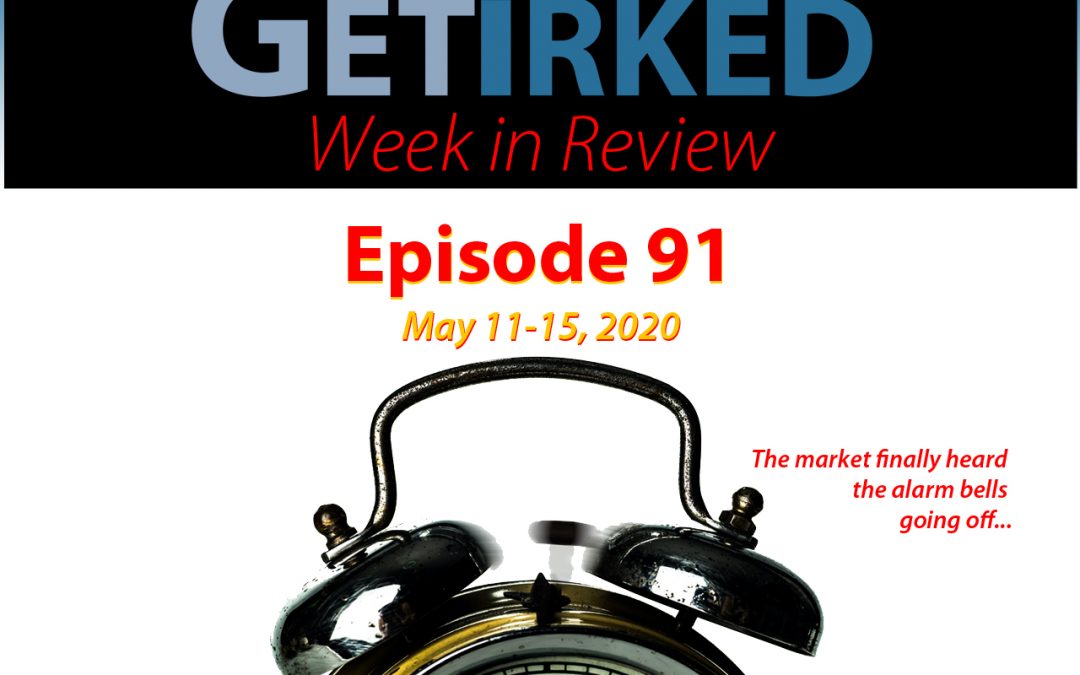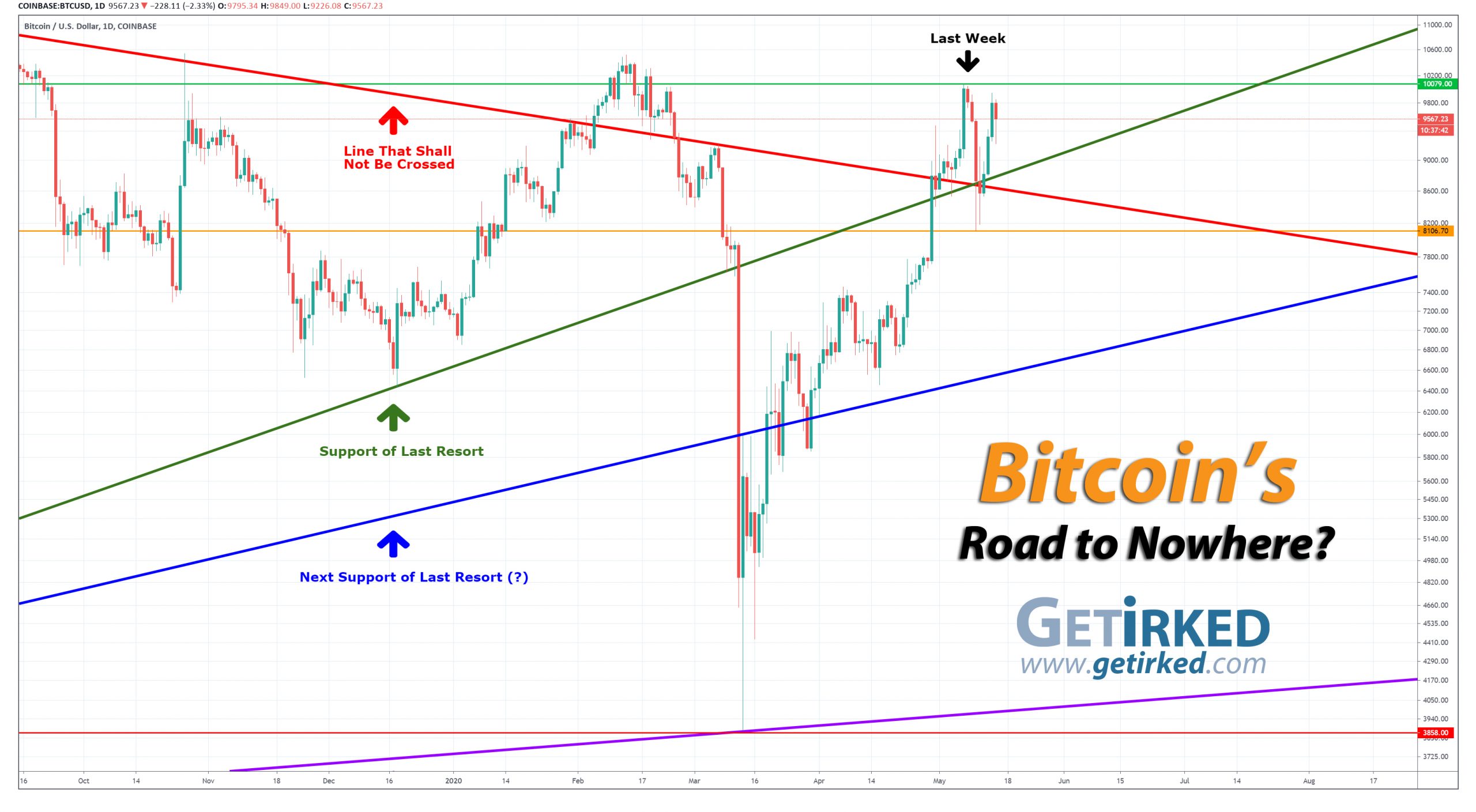Summing Up The Week
After whistling past the graveyard last week and Monday this week, the markets finally woke up on Tuesday with the release of negative health commentary and terrible economic data reports combining with jittery state economy reopenings.
The market selloff started mid-day Tuesday and continued in earnest throughout the week as report-after-report showed investors and traders that they were ignoring the data last week.
Essentially, the world’s going to be in poor economic shape for some time.
Let’s look at the news that moved the markets this week…
Market News
Economy Reopening Begins – Markets Remain Optimistic
As many states and companies worked to reopen their economies this week, the markets continued last week’s rally early in the week with investors closely monitoring economic efforts, ignoring pretty much all other news.
On Tuesday, the Bureau of Labor Statistics reported that consumer prices saw the biggest drop in history, at least since 1957 when recordkeeping started. On average prices of consumer goods (excluding eneregy and food) dropped 0.4% in April. The markets didn’t react to this news as a drop in prices was expected since almost all consumer activity has drawn to a halt due to COVID-19.
Fauci Delivers Somber Warnings – Market Listens
The stock market finally reacted to negative news on Tuesday when Dr. Anthony Fauci offered insights and warnings about the COVID-19 outbreak before a Senate committee, reported CNBC.
Facui told the committee that the U.S. could face more “suffering and death” if states move to reopen their economies too fast. He also said the U.S. would risk “multiple outbreaks” if the country reopened before filling the criteria provided by the White House, particularly with regards to testing capacity and a decline in hospitalizations.
The markets sold off following his testimony, closing at the session lows on Tuesday.
The Fed Chimes in – Prolonged Recession Possible
The stock market selloff which started Tuesday afternoon continued in earnest on Wednesday after Federal Reserve Chairman Jerome Powell shared concerns of a prolonged recession following issues throughout state’s reopening their economies, reported CNBC.
The markets, which appeared to be ignoring serious economic concerns for the past week, finally acknowledged the issues as investors took profits.
Trump Goes After China – 100 Trade Deals Wouldn’t Help
On Wednesday, President Donald Trump tweeted that “100 Trade Deals wouldn’t make up the difference [for] all those innocent lives lost” due to the coronavirus, reported CNBC.
Critics of the Trump administration have expressed concerns of Trump’s focus on finding blame for the COVID-19 coronavirus rather than focusing Federal government efforts on prioritizing the creation and distribution of testing equipment. The United States remains woefully underequipped compared to other countries and medical officials continue to point to testing as being key to reopening the economy.
2.981 Million More Unemployed – 36.5M Total
On Thursday, the Labor Department released its weekly unemployment report indicating nearly 3 million additional jobs lost in the past week, reported CNBC. Economists surveyed by Dow Jones in advance expected 2.7 million.
Continuing claims also rose by 456,000 to 22.83 million, indicating that those who have lost their jobs due to a freeze that was supposed to last two weeks have still not been brought back to work.
Retail Sales Plummet 16.4% vs. 12.3% Predicted
Friday kicked off with a terrible government report showing consumer spending collapsed a record 16.4% in the month of April versus 12.3% expected by economists surveyed by Dow Jones, reported CNBC.
Consumer spending is essentially the backbone of the American economy, so when the numbers come in that bad, it foretells a negative time ahead.
The categories with the largest losses month-over-month including clothing (-78.8%), electronics/appliances (-60.6%), and furniture (-58.7%), all down significantly just since one month earlier in March.
Next Week’s Gameplan
Unlike March when investors sold everything indiscriminately, this week’s selloff shows some names retaining strength with others losing all support.
We’re no longer in a straight Selling or Buying Season – stock-picking remains key. Some stocks are priced lower than they should be while others may seem cheap but are actually not good bargains at these levels.
As has been my plan the past few weeks, I plan to both add to positions and take profits in others depending on market moves both as a whole, but, more often than not, in specific sectors and even specific names.
This Week in Play
Stay tuned for this week’s episodes of my two portfolios Investments in Play and Speculation in Play coming online later this weekend!
Crytpo Corner
Important Disclaimer
Get Irked contributors are not professional advisers. Discussions of positions should not be taken as recommendations to buy or sell. All investments carry risk and all readers must accept their own risks. Get Irked recommends anyone interested in investing or trading any asset class consult with a professional investment adviser to determine if an investment idea is suitable to them and their investment goals.
Click chart for enlarged version
Bitcoin Price (in USD)
%
Weekly Change
Bitcoin Price Action
The Halvening, where the amount of Bitcoin released to miners got cut in half for the third time in its history, happened on Tuesday, May 12. The selloff bears expected following the halving seemed to take place with Bitcoin selling off -19.57% from its $10,079.00 high down to $8106.70.
However, the price action surprised speculators when Bitcoin bounced +22.66% from its new weekly low to $9943.93 on Thursday. While volatility has long been the name of the game in the cryptocurrency space, moves this large on a daily basis are certainly intense, even for Bitcoin.
The Bullish Case
Bulls argue that Bitcoin’s new scarcity – basically, the cryptocurrency version of quantitative tightening – makes Bitcoin a better store of wealth for the long-term versus individual countries’ currencies as reserve banks throughout the world are printing new money with no end in sight.
The Bulls continue to believe that March’s epic selloff provides immunity against further selloffs and that new institutional buying will result in Bitcoin heading to new all-time highs with some predicting a break of $20,000 by the end of the year and others holding price targets as high as $100,000 by the end of 2021.
The Bearish Case
Bears continue to believe that Bitcoin will sell off dramatically within the next 30-60 days as it has historically after previous halvings. Many bears believe we will see a test of the $3858.00 monthly low made in March, with some predicting Bitcoin will drop as low as $1700-1800 before rebounding.
Bitcoin Gameplan
Current Allocation: 3.605%
Current Per-Coin Price: $8,647.23
Current Status: +10.639%
I added to my allocation when Bitcoin showed surprising relative strength during its selloff this past week, increasing my per-coin price slightly by +0.56% from $8,599.27 to $8,647.23, however, my buys also increased my allocation to 3.605% from 1.615% in order to offer better exposure to potential upswings following the halving.
That being said, this position is still far from “all-in” as any price in Bitcoin above $5000 means I have to exercise significant risk management with much smaller position sizes to protect against that $3858.00 monthly low.
Bitcoin Buying Targets
Using Moving Averages and the $3858.00 monthly low as guides, here’s my plan of buying quantities and prices:
0.401% @ $8417
0.445% @ $8196
0.890% @ $7572
1.780% @ $6637
1.780% @ $5936
2.424% @ $5538
9.855% @ $4363
7.457% @ $3989
9.476% @ $3667
11.881% @ $3219
Bitcoin Selling Targets
Right now… no set selling targets. If Bitcoin settles at a point where I can lock in gains of 20-25% without setting stop-losses too close to the price, I may close this position and start a new one, but, for the moment, I’m curious to see where we’re headed.
Why the differing quantities at each level instead of a flat percentage?
Rather than buying an equal percentage, I change my buying quantity at each stage as a reflection of how likely Bitcoin could bottom and rebound from that stage. Rather than increasing my quantity on the way down, I’m used a fixed amount of money, so I’m basing how much I buy by how likely I think Bitcoin will drop to a certain level. In this case, I don’t think it’s likely Bitcoin will be able to break its $3128 low, so my quantities under that price point are less to account for the chances it will get to them.
No price target is unrealistic in the cryptocurrency space – Bullish or Bearish.
While traditional stock market investors and traders may think the price targets in the cryptocurrency space are outlandish due to the incredible spread (sometimes a drop of near -90% or a gain of up to +1000% or more), Bitcoin has demonstrated that, more than any speculative asset, its price is capable of doing anything.
Here are just a few recent price movements over the past couple of years:
- Bitcoin rose +2,707% from its January 2017 low of $734.64 to make an all-time high of $19,891.99 in December of the same year.
- Then, Bitcoin crashed nearly -85% from its high to a December 2018 low of $3128.89.
- In the first half of 2019, Bitcoin rebounded +343% from $3128.89 to $13,868.44.
- From June 2019, Bitcoin dropped -53.64% to a low of $6430.00 in December 2019.
- From December 2019’s low, Bitcoin rebounded +64% from $6430.00 to $10,522.51.
- In March 2020, Bitcoin dropped -63.33% to a low of $3858.00, mostly in 24 hours.
- From $3858.00, Bitcoin has rebounded +161.25% to $10,079.00 in May.
- Where will Bitcoin go from here? Truly, anything is possible…
What if Bitcoin’s headed to zero?
The only reason I speculate in the cryptocurrency space is I truly believe Bitcoin isn’t headed to zero.
I am prepared for that possibility, however, by knowing I could potentially lose all of the capital I’ve allocated to this speculative investment. Professional advisers recommend speculating with no more than 5% of an investor’s overall assets. Personally, I’ve allocated less than 2% of my assets to speculating in crypto.
I feel that anyone who doesn’t believe in the long-term viability of cryptocurrency would be better served not speculating in the space.
On a good day, this asset class isn’t suitable for those with weak stomachs. On volatile days, the sector can induce nausea in the most iron-willed speculator.
DISCLAIMER: Anyone considering speculating in the crypto sector should only do so with funds they are prepared to lose completely. All interested individuals should consult a professional financial adviser to see if speculation is right for them. No Get Irked contributor is a financial professional of any kind.
Get Irked in your Email?
We’re making a list and checking it twice! If there’s enough interest, we’ll start sending the Week in Review straight to your inbox!
Interested? Click here to sign up!
Ways to give back to GetIrked:
Send me a tip via Stripe! Thank you!
Get free money by signing up for an account with my referral link for Schwab
Sign up for Gemini and we each get $10
Click this referral link to get the Brave Browser
If you use Brave, you can also use the Tip function to tip me in Basic Attention Token (BAT).
Suicide Hotline – You Are Not Alone
Studies show that economic recessions cause an increase in suicide, especially when combined with thoughts of loneliness and anxiety.
If you or someone you know are having thoughts of suicide or self-harm, please contact the National Suicide Prevention Lifeline by visiting www.suicidepreventionlifeline.org or calling 1-800-273-TALK.
The hotline is open 24 hours a day, 7 days a week.


